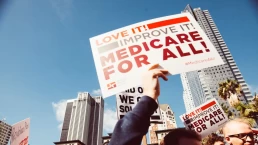I see a nation where 63 percent of workers live paycheck to paycheck — paycheck to paycheck. What does that mean? It means that every day you are living under incredible stress — scared to death that if your car breaks down, if your kid gets sick, if your landlord raises the rent, if you get divorced or separated, if you become pregnant, if for whatever reason you lose your job, you will find yourself in the midst of a financial catastrophe.
by Bernie Sanders
As we enter the new year, as Congress begins its legislative session next week, and as we have just finished celebrating the birthday of Dr. Martin Luther King Jr., one of the great fighters for justice in our nation’s history, it is appropriate that we ask two very simple questions.
One: What is everyday life like today for the vast majority of our people — the working class of this country, the middle class and lower income Americans? What are the pains, struggles, and the hopes that they are striving for? And secondly, what is Congress going to do to improve life for working families? In the year 2023, amidst an explosion of technology, massive wealth creation, and transformational economic change, how can we make certain that all Americans have the decent standard of living to which they are entitled? Is this a utopian idea? Is this pie in the sky or can we actually accomplish it? I think we can.

Now you might think that these very basic questions are discussed often on the floor of the Senate or in the House of Representatives or in the corporate media. Well, if you thought that — you would be wrong.
For a wide variety of reasons, having to do with money in politics and corporate ownership of the media, these are topics that are far too rarely discussed. And that’s the purpose of my remarks tonight and the kind of discussion I hope to stimulate. Members of Congress and Americans can disagree politically and philosophically as to where we may want to go in the years to come, but it’s imperative that we acknowledge the reality of today — and not run away from it.
To my mind, the most important economic and political realities now facing this country are the following:
(a) The long-term decline of the American middle class. This decline is not a new occurrence. It didn’t start in President Biden’s administration or in the years of Donald Trump. It’s been going on for 50 years.
(b) The unprecedented and obscene level of income and wealth inequality that currently exists. Never before in our history have we seen so few own so much as we see today.
(c) The rapidly growing concentration of ownership within our economy. In sector after sector a handful of giant corporations control what is produced and how much we pay for their products.
(d) The incredible and dangerous power that billionaires have over our political system. We can hardly be called a vibrant democracy when a handful of the wealthiest people in this country can spend hundreds of millions to elect the candidates of their choice.
(e) Putting that all together, what we are witnessing now in this country is the rapid evolution of our society into an oligarchy in which the billionaire class has enormous and growing control over the economic and political life of the United States. It is very easy for us to look at Putin’s Russia and talk about the oligarchy there. The time is long overdue for us to pay attention to oligarchy in our own country.
When we talk about what’s going on in this country, let us start off by taking a hard look at the state of our economy. And what you’ll find is that the economy is doing extraordinarily well, just fantastic — for the people on top, for the billionaire class. Unfortunately, it is not doing so well for the working class of our country as tens of millions of families fall further and further behind as they struggle to pay their bills and put food on the table.
The gross unfairness of our economy can be seen in stark terms when we look at how the working class and the billionaire class have made out during the pandemic. On one hand, tens of thousands of American workers died going to their jobs during the worst public health crisis in modern American history. These were nurses, bus drivers, meat packing workers, EMT staff, cops, firemen, teachers, grocery store workers, and many others. On the other hand, sitting safely in their homes or offices, the billionaire class became $2 trillion richer during that same period — often jacking up prices for their products. Desperate workers were forced to go to work in unhealthy and unsafe environments, and thousands of them died because they did their essential jobs and fed their families. Meanwhile, multi-billionaires like Elon Musk, Jeff Bezos and Richard Branson were out taking joy rides to outer space, buying $500 million yachts and living in mansions with 25 bathrooms.
Today, while more and more working-class Americans are unable to afford the health care they need, 3 people own more wealth than the bottom half of American society — 165 million people. Let me repeat: 3 people now own more wealth than the bottom 165 million Americans. We now have more income and wealth inequality than just about any other period in American history.
Today, while nearly 18 million American families are paying more than 50 percent of their limited incomes on housing, and nearly 600,000 are homeless, the top one percent owns more wealth than the bottom 90 percent of the American people.
Today, while millions of ordinary workers are working longer hours for lower wages, the CEOs of the largest corporations in America now make almost 400 times as much as the average worker — the highest CEO-worker differential on record.
In the 1950s, CEOs made about 20 times more than the average worker. In the 1980s, CEOs made 59 times more than the average worker. In 2009, CEOs made about 180 times more than the average worker. And today, according to the latest figures, CEOs make 399 times what the average worker makes.
But this long-term trend of growing inequality in America is more than the outrageous compensation gap between CEOs and workers. Since 1975, there has been a massive redistribution of wealth in America. The problem is that it has gone in precisely the wrong direction.
Over the past 48 years, according to a study done by the Rand Corporation, more than $50 trillion in wealth has been redistributed from the bottom 90 percent to the top 1 percent — primarily because a growing percentage of corporate profits have been flowing into the stock portfolios of the wealthy. $50 trillion dollars going from the bottom to the top.
And it’s not just income and wealth inequality that is plaguing our nation. It is the maldistribution of economic and political power.
Today we have more concentration of ownership than at any time in the modern history of this country. In sector after sector — financial services, energy, food, transportation — a handful of giant corporations control what is produced and how much we pay for it. Unbelievably, just three Wall Street firms (BlackRock, Vanguard and State Street) control assets of nearly $20 trillion and are the major shareholders in 96% of S&P 500 companies. And if you wonder why you don’t hear this discussed in the media maybe, just maybe, it has something to do with the fact that some six multi-national media conglomerates own and control some 90% of what the American people see, hear, and read.
Some of you may recall that in Franklin Delano Roosevelt’s second inaugural address in 1937, after he won a second term in office, he famously said: “I see one-third of a nation ill-housed, ill-clad, ill-nourished.”
Well, I am not here to tell you that the state of the American economy today is as bad as it was during the Great Depression. It is certainly not. But, as the incoming Chair of the Health, Education, Labor and Pensions Committee (HELP), when I look out across the country in the year 2023, this is what I see.
I see a nation where 63 percent of workers live paycheck to paycheck — paycheck to paycheck. What does that mean? It means that every day you are living under incredible stress — scared to death that if your car breaks down, if your kid gets sick, if your landlord raises the rent, if you get divorced or separated, if you become pregnant, if for whatever reason you lose your job, you will find yourself in the midst of a financial catastrophe. Living paycheck to paycheck leaves you with no sense of security, no cushion to fall back on, and no quality time to spend with your family in a relaxed environment. It is one of the reasons why the life expectancy of working people is much lower than those who are upper-income.
I see a nation where nearly a third of our workforce — almost 52 million workers — earn less than $15 an hour.
Let’s do the economic math. If a full-time worker makes $15 an hour — at most — that worker receives an income of $31,200 before federal, state and local taxes. Well, today, the average landlord in America is asking new tenants to pay $1,900 a month for rent, $22,800 a year. The average household in America spends over $5,200 a year on groceries. And then there are the costs of childcare and education, health care, medicine, transportation, clothing, a cell phone, and a computer.
You tell me. How is anyone able to survive when your basic needs cost more than your income? And that’s the reality that millions of working-class Americans experience every single day. These are people who work hard, and fall further and further behind.
Let’s be clear. What we are seeing today is not some kind of radical economic transformation suddenly hitting our country. The shrinking of the American middle class has been going on for decades.
In America today, I see a nation where the average worker makes $54 a week less than he or she did 50 years ago — after adjusting for inflation. Think about that for a moment. Think about all of the incredible advancements in technology that have been made over the past 50 years — computers, robotics, artificial intelligence — and the huge increase in worker productivity that has been achieved during that time. And yet, when all is said and done, real weekly wages for the average American worker are lower today than they were in 1973. How is that possible? And the answer is that virtually all of the economic gains created by modern technology have financially benefited the people on top, not working people.
Is it any wonder that today it takes two breadwinners in most households to pay the bills when 50 years ago it was usually one worker that did that?
When we talk about the conditions facing the American working class, it’s not just wages and income. It’s about whether people can access the basic necessities of life. And there is nothing more basic than health care.
In terms of health care, I see a nation where over 85 million of our people are either uninsured or under-insured, where over 500,000 people go bankrupt each year because of medically related debt, and where over 68,000 people die each year because they can’t afford the health care they need.
I see a nation that spends over twice as much per-capita for health care than other major nations, nearly $13,000 for every man, woman, and child in the country and yet has worse health outcomes and lower life expectancy than most developed nations — all the while the insurance companies make tens of billions in profits. It is a broken and dysfunctional health care system that cannot even produce the number of doctors, nurses, dentists, and mental health specialists we desperately need.
I see a nation that pays, by far, the highest prices in the world for prescription drugs, while the pharmaceutical industry makes record-breaking profits and more than a few executives in drug companies become billionaires. Meanwhile, despite billions in government investment in prescription drug research and development, nearly one out of four Americans are unable to afford the medicine their doctors prescribe.
And because Medicare doesn’t cover dental, hearing, or vision, there are millions of lower-income seniors who don’t have teeth in their mouths because they can’t afford dental care. Many other seniors lack the hearing aids and eyeglasses they need.
In terms of education and how we treat our young people, I see a nation where, disgracefully, we now have the highest rate of childhood poverty of almost any nation on earth and millions of kids, disproportionately Black and Brown, face food insecurity. I see a nation where we can somehow afford to provide over a trillion dollars in tax breaks to the top one percent and large corporations, but our teachers and children get broken chairs, flooded classrooms, and inadequate staff support — and where many thousands of our teachers and teaching staff are inadequately paid.
I see a nation where hundreds of thousands of bright young people who have the desire and the ability to get a higher education cannot do so because their families lack the money, and a nation in which 45 million more are drowning in student debt.
While psychologists tell us that the first four years are the most important for human intellectual and emotional development, I see a nation which has a totally dysfunctional childcare system which costs, on average, over $15,000 a year per child, a system where there are not enough slots for kids and a system where the average childcare worker is paid just $13.30 an hour — less than a parking attendant or a doggy day care worker. No. That’s not the way to treat our infants and toddlers — the future of our country.
Meanwhile, we remain the only major country on earth without paid family and medical leave.
So yes, we must work toward creating the best-educated workforce in the world, one that prepares our children to succeed in a highly competitive global economy — one that recognizes a high-quality public education from childhood to adulthood is the right of all, not just the privilege of a few.
In terms of labor, not only do I see a nation with a rigged economy and an unprecedented level of income and wealth inequality, I see workers from Vermont to California, at companies like Starbucks and Amazon, at hospitals, in factories and on college campuses, fighting back against corporate greed and organizing unions to receive better wages, benefits, and working conditions.
Unfortunately, and unacceptably, I see major corporations engage in vicious and illegal union busting behavior as they attempt to deny workers their constitutional right to form unions.
Why do we want to grow the union movement and support workers who are trying to organize? Because unions provide better wages, benefits and working conditions for their members. In fact, union workers make, on average, wages that are about 20 percent higher than their non-union counterparts. They also have much better health care and far better pension plans than non-union employees. And, by the way, when unions win decent contracts for their employees they drive up wages for all workers in the country.
And when we talk about low-wage jobs in America we must talk about raising the minimum wage to a living wage. Unbelievably, the federal minimum wage of $7.25 has not been raised since 2009, and tipped minimum wage workers have been stuck at a miserable $2.13 for over thirty years. So yes, we must follow the lead of some states around the country and raise the minimum wage to a living wage. We must stand up to the extraordinary greed and power of corporate America and make it possible for workers to exercise their constitutional rights to organize unions. We must end the international embarrassment of the United States of America being the only major country on earth that does not guarantee paid family and medical leave, paid sick days or paid vacation days.
In terms of pensions, I see a nation where half of older Americans have no retirement savings and no idea how they will ever be able to retire with any shred of dignity.
I see a nation where 55 percent of senior citizens are trying to survive on an income of less than $25,000 a year.
To my mind, we need to expand defined benefit pension plans in America — which sadly are an endangered species in our country.
We must expand Social Security benefits, not cut them.
My fellow Americans: There is a lot of discussion in the media about how “divided” our nation is and, on many issues, that is absolutely true. But what we don’t appreciate is that on some of the most important issues facing our country the American people — Democrats, Republicans, Independents, Progressives, Conservatives — are quite united.
The American people know that we are being ripped off by the greed of the pharmaceutical industry and they want substantially lower prescription drugs prices.
The American people know that our health care system is outrageously expensive, bureaucratic and wasteful — and they want universal and lower cost health care.
The American people know that education is essential to our lives and the future of this country, and they want high quality and affordable public education from childcare to graduate school.
The American people know that no one can survive on $7.25 an hour minimum wage and they want to raise the minimum wage to a living wage.
The American people know that workers have a constitutional right to form unions and that corporations that engage in illegal union busting activities must be held accountable.
And these are just a few of the issues within the jurisdiction of the HELP Committee that a strong majority of the American people want us to address.
So, if you asked me today, “What is the state of a struggling working class?” I would tell you that the working class is united around an agenda that meets the needs of ordinary Americans and not just wealthy campaign contributors.
At a time when too many Americans are giving up on democracy now is the time for all of us — Democrats, Republicans and Independents — to attempt to restore faith in our government. Now is the time for Congress to have the courage to take on powerful corporate interests and their lobbyists who flood Capitol Hill — and show the American people that our government can work for them, and not just the 1 percent.
And let me add, it is imperative that we take the discussion of all of these important issues and more, outside of Washington and into communities across the country.
I look forward to hearing directly from workers about the struggles they face on their jobs, from seniors who face outrageously high health care costs, from young people who don’t want to leave college deeply in debt, and from parents who want high quality and affordable childcare.
In this difficult moment in American history let us have the courage to stand together and fight back against corporate greed. Let us fight back against massive income and wealth inequality. Let us fight back against a corrupt political system. Let us listen to the needs of working families, and not just corporate CEOs.
Finally, let us stand together and finally create an economy and a government that works for all, not just the 1 percent.
Recent Posts
FBI Making List Of American “Extremists,” Leaked Memo Reveals
December 8, 2025
Take Action Now Are you on Trump’s naughty list?By Ken Klippenstein, KenKlippenstein.com Attorney General Pam Bondi is ordering the FBI to…
We’ve Reached The Medicare For All Tipping Point
December 7, 2025
Take Action Now With the health care crisis spiraling out of control, a pivotal majority of Americans now support a single-payer system.By David…
Zohran Mamdani & Bernie Sanders Join Striking Starbucks Workers
December 6, 2025
Take Action Now ‘This is a union town.’ Zohran and Bernie join the Starbucks picket line to demand the coffee giant reach a fair contract…
Canadian Liberals Fear Closing Arms Export Loophole Would Anger U.S.
December 5, 2025
Take Action Now A leaked briefing document gives the full picture behind the government’s talking points.By Alex Cosh, The Maple A leaked Liberal…




